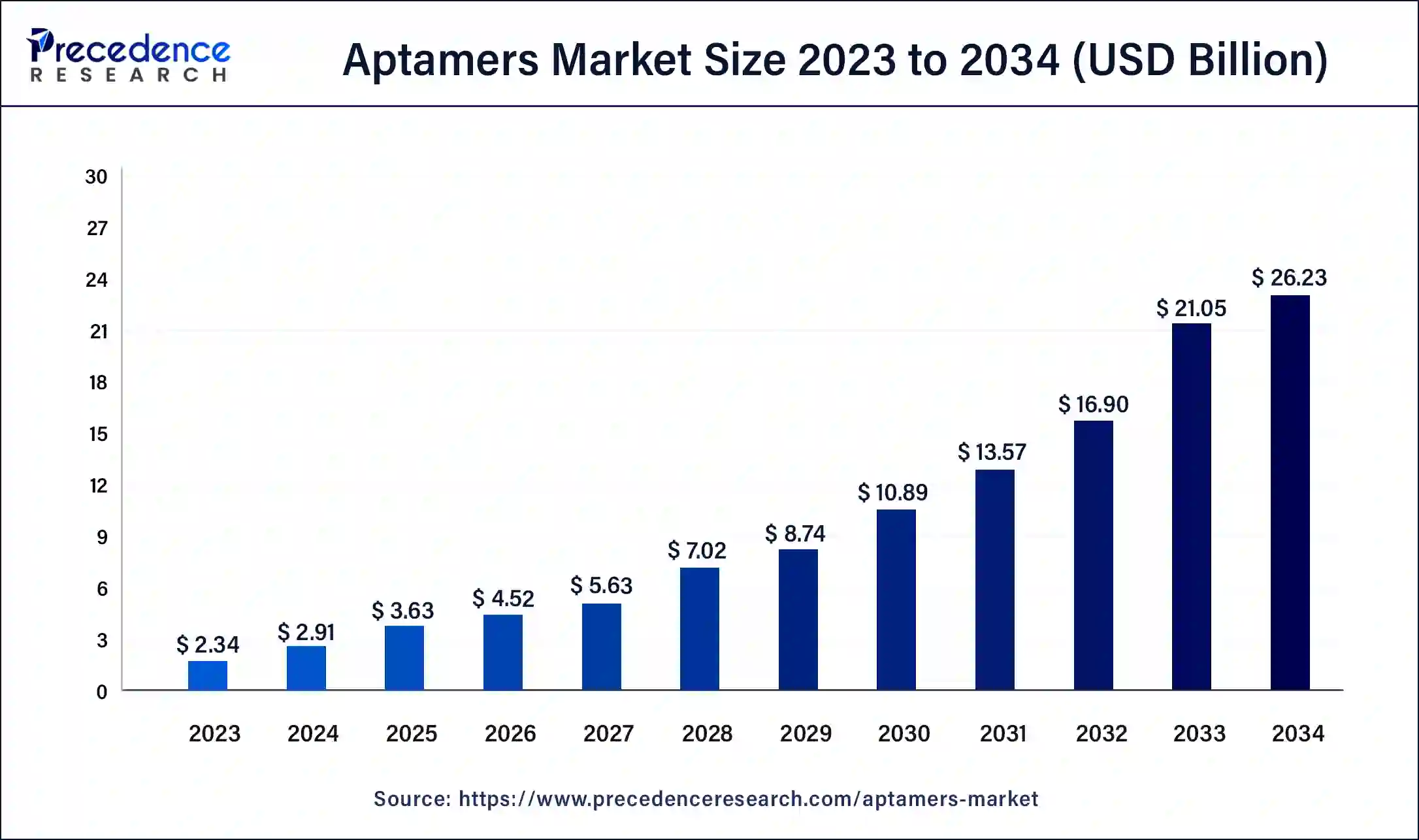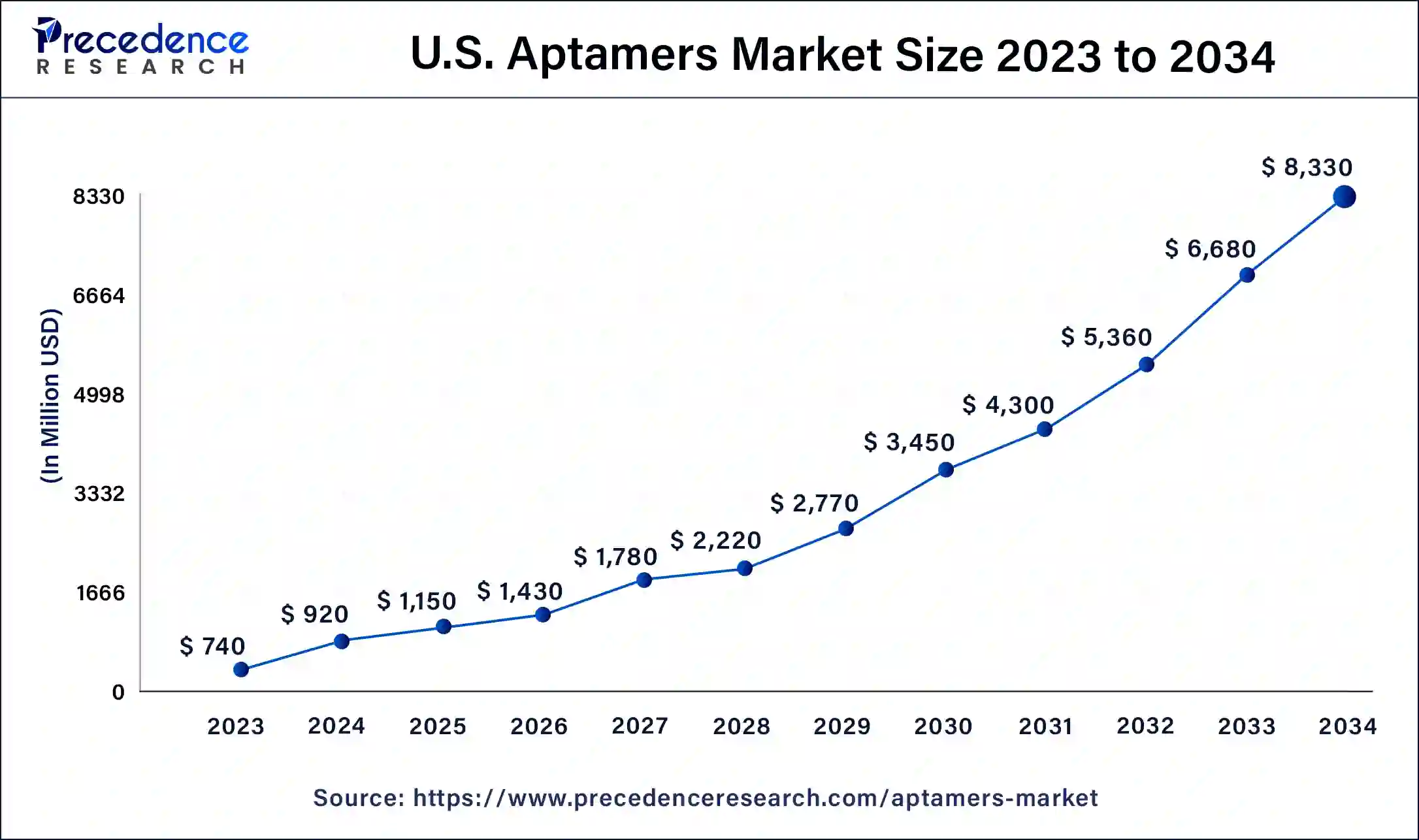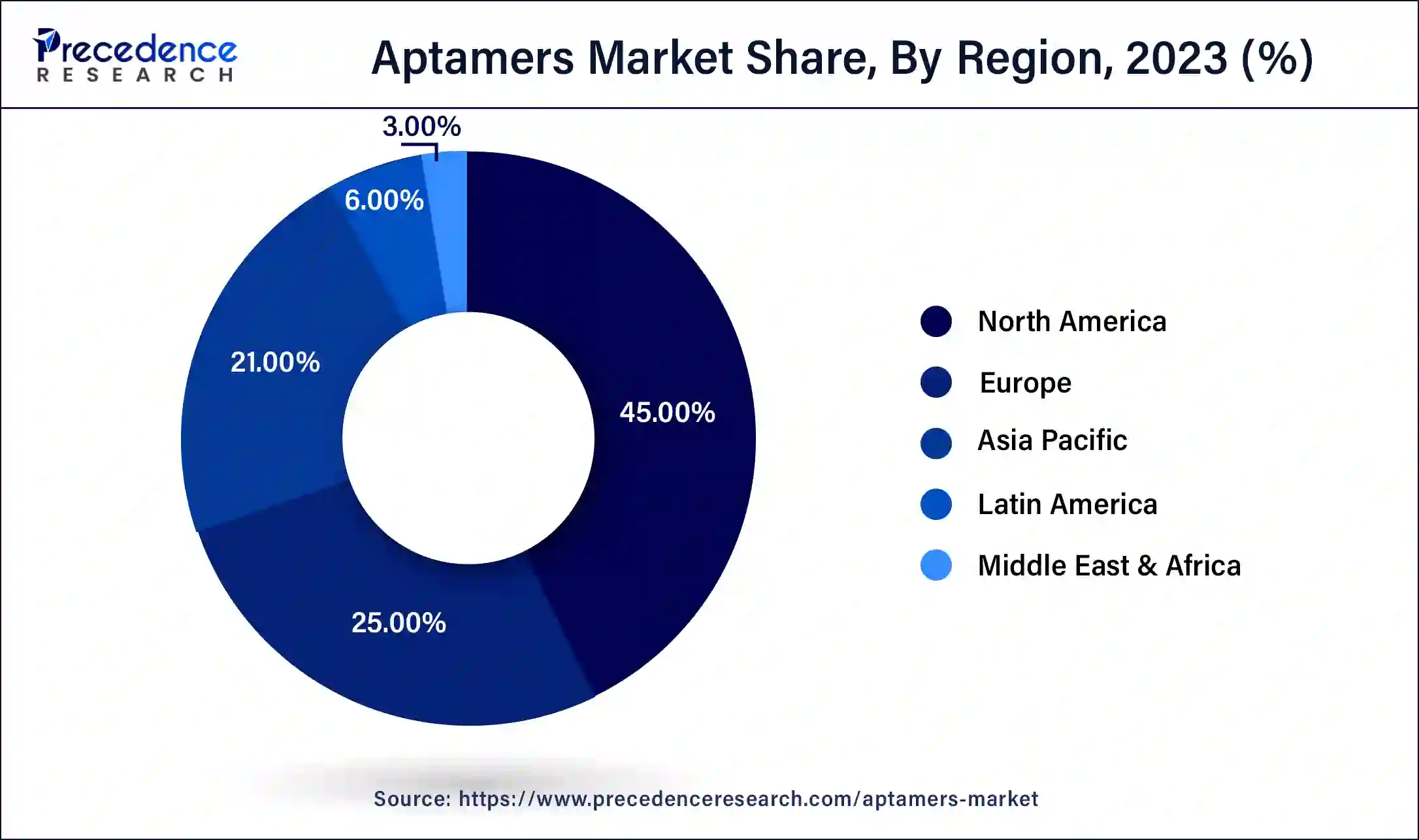The global aptamers market size was USD 2.34 billion in 2023, calculated at USD 2.91 billion in 2024 and is expected to be worth around USD 26.23 billion by 2034. The market is slated to expand at 24.57% CAGR from 2024 to 2034.
The global aptamers market size is worth around USD 2.91 billion in 2024 and is anticipated to reach around USD 26.23 billion by 2034, growing at a solid CAGR of 24.57% over the forecast period 2024 to 2034. The North America aptamer market size reached USD 1.05 billion in 2023.The increasing prevalence of chronic disorders, growing research and development, and increasing investments drive aptamers market growth.

The U.S. aptamer market size was exhibited at USD 740 million in 2023 and is projected to be worth around USD 8,330 million by 2034, poised to grow at a CAGR of 24.69% from 2024 to 2034.

North America held the largest share of the aptamers market in 2023. The rising prevalence of chronic disorders, state-of-the-art research and development facilities, advanced healthcare infrastructure, and increased investments and collaborations drive the market. The total private investments in biotech in the U.S. were around $21.7 billion in 2022. It is also reported that around $89.6 billion was contributed by pharmaceuticals and medical manufacturing to Canada’s GDP in 2022.
The market is also driven by increased novel drug approvals and increasing demand for precision medicine. To date, the USFDA has approved 12 precision medicines. The number of clinical trials conducted in the region, especially in the US and Canada, demonstrates a positive potential for the aptamers market. The Canadian Institutes of Health Research (CIHR) has invested $1 billion in health research funding, including $250 million for a new CIHR Clinical Trial Fund. According to clinicaltrials.gov data, 37 clinical trials were conducted involving aptamers for different applications. Out of these, 21 clinical trials were conducted in the US, and 2 were conducted in Canada.

Asia-Pacific is projected to host the fastest-growing aptamers market in the coming years. The increasing population, increasing awareness about aptamers, growing research and development activities, and increasing investments drive the market. The market is also driven by growing pharmaceutical & biotechnological industries. In 2022, India invested $1 billion in biotechnology R&D. The value of Chinese biotech venture deals, including the U.S. investors in 2022, was $102.6 million. The increasing cases of cancer demand fast and efficient diagnosis and treatment strategies. The emergence of COVID-19 has increased the awareness and significance of aptamers in the region. The rising demand for clinical diagnostics also boosts the market.
Aptamers are short, single-stranded DNA or RNA molecules that bind to a specific target, such as proteins, peptides, carbohydrates, small molecules, or toxins. They are extremely versatile and bind targets with high selectivity and specificity. Aptamers are used for numerous applications, from diagnosis to treatment. Due to their structural similarity, they can replace antibodies and are used in immunoassay techniques like ELISA, western blot, and immunohistochemistry. They also detect diseases like cancer and viral disorders and act as biomarkers. They are promising therapeutic agents since they are cheap, non-immunogenic, and easy to modify. They act as drug delivery vehicles, controlled release mechanisms, and reagents for drug discovery and precision medicine. Additionally, they aid in protein production monitoring, quality control, purification, and modifying proteins.
How Can AI Help the aptamers market?
Artificial intelligence (AI) can boost aptamer research and its use in diagnosing and treating several disorders. Several researchers have investigated the role of AI in various aptamers applications. Computational methods can predict the affinity of aptamers toward different targets. These computational methods and online servers help to predict the secondary and 3D structure of aptamers, thereby reducing the time and cost of tedious laboratory tasks. Additionally, an AI technique can be utilized to increase the accuracy of aptamer sequence detection. Hence, AI holds immense potential to revolutionize the research involving aptamers.
PentaBind is at the forefront of developing aptamers-based therapeutic drugs, leveraging the synergy of generative AI and integrated wet lab techniques. PentaBind’s AI-driven technology can concurrently design highly tunable and successful therapeutic aptamers.
| Report Coverage | Details |
| Market Size by 2034 | USD 26.23 Billion |
| Market Size in 2024 | USD 2.34 Billion |
| Market Growth Rate from 2024 to 2034 | CAGR of 24.57% |
| Largest Market | North America |
| Base Year | 2023 |
| Forecast Period | 2024 to 2034 |
| Segments Covered | Type, Application, and Regions |
| Regions Covered | North America, Europe, Asia-Pacific, Latin America and Middle East & Africa |
Increasing demand for clinical diagnostics
Clinical diagnostics are agents used to detect a disease or condition based on the patient’s symptoms. In the field of diagnostics, aptamers are used to detect infective agents, antigens/toxins, biomarkers (cancer), or a combination. Hence, it has emerged as a detecting agent for several bacterial, parasital, and viral diseases along with cancer. The most commonly used detecting agent is aptamer-nanoparticle conjugates. These conjugates can identify several cancer metabolites or cancer biomarkers.
Aptamers offer superior benefits over conventional protein-based antibody methods in detecting infectious diseases. Aptamers are comparatively stable and give robust and accurate results. Additionally, they do not require a lot of reagents and instruments like PCR and ELISA. Hence, the rising cases of chronic disorders and increasing demand for point-of-care diagnostics augment the market. Furthermore, the rise in diagnostics laboratories globally boosts the potential for the aptamers market. The US reports around 26,519 diagnostic and medical laboratories, while India reports more than 100,000 diagnostic laboratories as of 2023.
Rapid degradation and high cost
The major limitation of aptamers is their rapid degradation (especially RNA aptamers) by nucleases in the biological media due to their interactions with biomolecules. This ultimately reduces their half-life and the amount of time stayed within the body. The high cost of aptamers also limits their use by many research institutions and combats their scalability. The production of aptamers requires complex methods and huge capital investment. The average price of aptamers ranges from $300 to $5000. Furthermore, the use of aptamers in clinical diagnostics and laboratory research requires skilled professionals. The lack of trained professionals hinders the aptamers market growth.
Increased demand for precision medicine
The rising prevalence of chronic disorders necessitates the early identification and treatment of the disease. Precision or personalized medicine is an innovative approach to tailor disease prevention and treatment, taking into account people’s genes, environments, and lifestyles. The diversity in a person’s genetic makeup limits the effect of medicines designed for a large population. The role of aptamers in precision medicine has emerged for treating various disorders, especially cancer and autoimmune disorders. Aptamers bind to a vast spectrum of targets in cancer patients, providing more options to treat cancer. They can be easily modified and conjugated with different anticancer agents. They also possess a high affinity and specificity for their targets and exhibit fewer side effects than normal tissues. Additionally, aptamer-based detection of circulating targets also aids in developing precision medicines.
Aptamer Group’s Sales Rise of £2.1 Million
Aptamer Group, a York-based life sciences firm, announced a £2.1 million pipeline of the sales agreements of the year ended on June 30, 2024. The company develops binders through its Optimer platform for innovative approaches within therapeutics, diagnostics, and research applications. It reported a surge in sales as the year progressed, with an unaudited revenue of £0.85 million. Out of this, £0.55 million was generated in the year’s second half. £0.98 million were won in orders in the last quarter, resulting in a total of £1.8 million in signed orders, putting the company in a strong position. Additionally, the company currently has £2.1 million worth of advanced sales negotiations in the pipeline. In the fiscal year, the company collaborated with Unilever to deliver Optimers for use in personal care products. It is also looking forward to more collaborations with top pharma companies for their projects involving Optimer delivery vehicles for fibrotic liver disease.
The nucleic acid segment accounted for the largest share of the aptamers market in 2023. Nucleic acid aptamers are single-stranded DNA or RNA that fold into unique three-dimensional structures. Nucleic acid aptamers play a pivotal role in the diagnosis and treatment of various diseases. They act as biosensors for the real-time detection of a disease. They are also used as drug delivery systems for targeted and sustained delivery of drugs. Hence, the rising prevalence of several disorders and increasing investments increase the demand for nucleic acid aptamers.
The peptide aptamer segment is expected to grow at a significant rate in the aptamers market during the forecast period of 2024 to 2034. Peptide aptamers are short peptides (5-20 amino acids) derived from a random library of peptides to selectively bind to specific protein targets in vivo. Peptide aptamers find diverse applications in biomedical, biomedical, and bioanalytical fields. They mimic antibodies structurally and chemically, having high specificity and affinity and lower toxicity and immunogenicity. They are being used as a fundamental research tool and employed in drug target validation and drug discovery.
The research & development segment dominated the aptamers market globally in 2023. The state-of-the-art research and development activities globally have identified the significance of aptamers. Researchers are constantly investigating the role of aptamers due to their unique properties and dynamic applications across various domains. Aptamers have immense potential in diagnosing and treating several disorders. The rising investment in biotechnology and pharmaceutical R&D boosts the market. The U.S. Department of Health and Human Services invested $40 million to advance the National Biotechnology and Biomanufacturing Initiative.
The therapeutics segment is predicted to witness significant growth in the aptamers market over the forecast period. Since aptamers can be easily modified, several researchers are constantly evaluating the role of aptamers in treating several disorders. Aptamers are investigated for the treatment of several eye disorders like age-related macular degeneration, retinopathy of prematurity, and diabetic retinopathy. Novel antithrombotic aptamers are derived for their use in thrombosis and vascular diseases like hemorrhages by inhibiting coagulation proteases, antifibrolytic proteins, and proangiogenesis factors.
Aptamers have immense therapeutic potential in cancers like leukemia, prostate cancer, breast cancer, etc. They also have therapeutic potential in other disorders like infectious and inflammatory. Several other rapidly developing fields include aptamer-based drug delivery, infectious materials, diseased organs such as the brain with slow virus encephalopathy, and modulation of systemic disease through the delivery of miRNAs.
Segments Covered in the Report
By Type
By Application
By Geography
For inquiries regarding discounts, bulk purchases, or customization requests, please contact us at sales@precedenceresearch.com
No cookie-cutter, only authentic analysis – take the 1st step to become a Precedence Research client